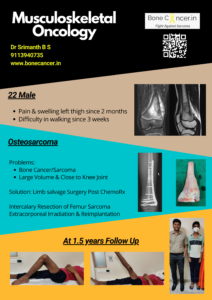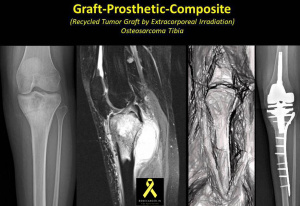Osteosarcoma
Symptoms| Signs | Treatment
Osteosarcoma is the most common primary bone sarcoma affecting children and adolescents.
What are causes ?
- The etiology of osteosarcoma is unknown.
- It arises primarily from aggressive bone producing spindle cells.
- Various risk factors have been identified such as
- Age (growth spurt period, 10 to 30 years),
- As a secondary tumor of bone related to
- Paget’s disease
- Fibrous Dysplasia
- Radiation induced
- Certain hereditary syndromes like Li-fraumeni syndrome (p53 gene), Retinoblastoma (Rb gene), Rothmund Thomson syndrome, Bloom syndrome, Werner syndrome and Diamond-blackfan anemia.
What are symptoms and signs ?
Osteosarcoma | Symptoms| Signs | Treatment
- Onset of Symptoms: 3-6 months duration
- Pain is a predominant symptom. Night Pain OR Rest pain
- Swelling in associated, rapidly progressive.
- Pathological fracture with trivial trauma
- Loss of weight and appetite follow in advanced cases
What bones are affected ?
- Common around Metaphysis and Diaphysis
- Long bones (Common around knee and shoulder)
- Pelvis, spine and short bones are rare.
What are tests done to identify Osteosarcoma?
https://bonecancer.in/2020/05/01/arriving-at-diagnosis-services/
https://bonecancer.in/2020/05/01/biopsy/
- Thorough Physical examination
- Plain Radiograph
- MRI with contrast
- CT scan
- Image Guided biopsy (specific IHC stains may be used on specimen)
- Whole body FDG PET CT scan
- Blood tests-LDH, ALP, ESR, CBC
Is Osteosarcoma Aggressive?
- Osteosarcoma is an aggressive neoplasm.
- The most common presentation (80%) is of primary site involvement without any distant
- Distant metastases (Most commonly in Lungs) can be identified in 15 to 20 % of individuals at time of presentation or diagnosis.
- Distant Metastases (To other bones) is uncommon (Represents highly aggressive nature with poor prognosis)
What are the types ?
Yes, Based on Location and Pathology as per World health Organization (WHO)
- Low-grade central osteosarcoma
- Conventional osteosarcoma
- Chondroblastic osteosarcoma
- Fibroblastic osteosarcoma
- Osteoblastic osteosarcoma
- Telangiectatic osteosarcoma
- Small cell osteosarcoma
- Secondary osteosarcoma
- Surface osteosarcoma
- Parosteal osteosarcoma (Low Grade)
- Periosteal osteosarcoma
- High-grade surface osteosarcoma
All Osteosarcomas (except low grade and parosteal) are considered to be intermediate grade and above.
How is Osteosarcoma treated?
- The work up is discussed in a multi-disciplinary committee and treatment is individualized according to stage.
- Multidisciplinary team (Tumour Board) involves Medical Oncologist, Orthopaedic Oncosurgeon, Radiologist, Pathologist, Radiation Oncology, Social worker and Psychologist.
- The historical treatment with surgery alone (amputation) or radiotherapy provided survival rates of 15-20 %.
- After the advent of chemotherapy and limb salvage surgery with improvement in imaging (1980 onwards), the rates of survival have increased to 65-74 % (5 years survival rate).
- Radiotherapy is used infrequently (Resistance), in inoperable cases with chemotherapy with limited benefit.
What chemotherapy is provided ?
- High grade & Intermediate Sarcomas require a combination of Chemotherapy and Surgery.
- Different Drugs and Regimens are used.
- Methotrexate based (MAP) or Ifosfamide based Regimens in Addition to Adriamycin and Cisplatin (IAP) are two most used worldwide.
- Chemotherapy is administered as Preoperative and Postoperative Regimens.
How is Limb Salvage performed ?
- Certain bones in our body are expendable and do not require any further reconstructive or salvage procedures like clavicle, rib, scapula, sternum, distal ulna and ilium.
- The primary tumor is removed with adequate surrounding normal tissue margins always.
- Ideally, Limb salvage surgery is performed after 10-12 weeks of perioperative chemotherapy.
- Low grade & Parosteal are adequately treated with surgery alone.
- Intermediate Osteosarcoma may benefit from upfront surgery and postoperative chemotherapy in some situations.
- Reconstruction of the resultant defect is tackled by different reconstructive options due to complexity of the musculoskeletal system.
- These are Bone Grafts (Autologous or Allogeneic) which can be segmental (intercalary) or osteoarticular aided with implants
- Metallic Endoprosthesis (Megaprosthesis)
- Allograft-Prosthesis Composite (APC)
- Extracorporeal radiation and Re-implantation (ECRT)

- Vascularized fibula construct
- Allograft resurfacing.
- In children and adolescents who have tumors involving growth plate and residual growth remaining, an APC or Expandable Endoprosthesis (invasive or non-invasive) are performed.

- In individuals who have attained skeletal maturity, most common options are adult endoprosthesis and reconstruction using different modes of Bone grafts as outlined above.
- In case of involvement of shaft or diaphysis of long bones and pelvis, the removed tumor bone can be irradiated and re implanted or substituted with allograft.
What is the treatment for Metastases ?
- Most common site is Lung. Bone involvement is uncommon.
- A whole body fdg pet ct scan follows for staging.
- If an individual has distant metastases (lung most common), it can be surgically removed after removal of the primary tumor.
- Chemotherapy is necessary, but regimens of drugs may differ.
- With aggressive treatment of lung metastases, nearly 40-45 % of such individuals survive for more than 5 years after relapse.
- But, the survival is reduced to 15-20 % post removal of local recurrence.
What are the rehabilitation steps involved post limb salvage?
- Rehabilitation post-surgery is dependent on the type of limb salvage.
- In case of bone graft reconstruction or APC, the involved limb is protected from bearing load or weight for a duration of 6 – 9 months to allow sufficient healing and bone graft incorporation.
- When endoprosthesis reconstruction is performed in pelvis and lower limbs, protected weight bearing and walking is allowed from the second postoperative day.
How often should I visit the doctor?
- The individual is followed up every 3 months for the first 2 years, followed by 6 months every 3 years (aggressive monitoring of the patient until 5 years).
- An individual who does not have any adverse events such as distant metastases or local recurrence during 5 years from time of occurrence of primary tumor have a 5 year survival rate of 65 – 75 % (which can be extended to the normal lifespan).
For More Information CONTACT US


